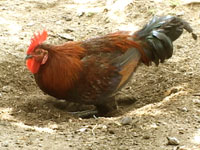Native chicken seen to boost farmers' income

Success for Western Visayas farmers will hopefully spring right from their own backyards as the region prepares for the full-blown commercialization of its native chicken.
In a two-day forum on December 8-9, agriculturists, farmers, academicians, researchers and businessmen discussed techniques in the breeding and production of native chicken, locally known as "darag."
They also discussed its historical development as well as its marketing and business options and prospects.
"There is definitely a growing market and this means business opportunities for our farmers," said Joseph Edward Idemne, director of the Western Visayas Agriculture and Resources Research and Development Consortium (WESVARRDEC).
Idemne said that with the completion of researches, agencies and advocates of "darag" chicken are now preparing for its commercialization.
Agencies and state colleges and universities under the consortium have been conducting researches on the indigenous strain for the past three years. But the earliest studies were conducted since 1985 by the West Visayas State University spearheaded by retired animal scientist and the school's former president Dr. Bernabe Cocjin.
Researches on the various aspects of "darag" chicken were also conducted by the Department of Agriculture, Capiz State University, School of Technology (SOTECH) and College of Management (CM) of the University of the Philippines in the Visayas, Iloilo State College of Fisheries-Dingle Campus, Aklan State University and the Central Philippine University.
The "darag," Hiligaynon for yellow, is the dominant native strain on the islands of Panay, Negros and Guimaras. The native chicken is so named because of its dull yellow-gold plumage with dark brown markings outlining the neck feathers.
The strain evolved from the Red Jungle Fowl (Gallus gallus bankiva), according to a primer of the Philippine Council for Agriculture, Forestry and Natural Resources Research and Development (PCARRD).
Through years of research, the various agencies and institutions developed a breeding system for the conservation, improvement and utilization of the "darag" native chicken.
The rooster locally called "labuyo" has red wings and hackles with black feathers on its tail. The hen, also called "darag", is typically yellowish-brown.
"Darag" eggs hatch from 18 to 21 days and go through brooding for 20 days. They become matured and ready for slaughter between 75 to 120 days after they undergo a "hardening" stage when they are prepared for rugged conditions to ensure their survival.
Demand for native chicken has significantly grown in recent years because of its distinct taste compared to broilers and the growing recognition of its nutritious value.
"Darag" chicken is preferred because of its leaner meat and sought-after flavor attributed by scientists to amino acids such as aspartic and glutamic acids. Its eggs and meat also have less cholesterol.
Aside from popular "lechon manok" (whole roasted chicken rubbed with spices and stuffed with lemon grass) "darag" is also in demand for popular dishes like "adobo" (chicken stewed in vinegar, soy sauce and spices) and "tinu-om" (chicken soup with spices and small knot of lemon grass and placed on layers of banana leaves).
Idemne said demand for the "darag" chicken in Iloilo City alone has reached an estimated 600,000 heads annually with restaurants and barbecue stands among the main buyers.
"The demand is there. Our problem is the supply," said Idemne.
Feljean Cagape, a "darag" breeder from Barangay Panginman in Leon town, said he could not meet the demand from buyers from the neighboring towns of Oton, Tigbauan, Alimodian and San Miguel in Iloilo.
An agriculturist who started breeding "darag" chicken in 2003, Cagape earns a profit of P26 for each head that he sells mostly to chicken inasal vendors. He sells chickens weighing 750 grams to 1 kilo from P120 to P180 per head.
"It is more profitable because it requires less feeds, water and maintenance compared with broilers and hogs," said Cagape.
Idemne said business opportunities are not limited to selling heads for slaughter. Farmers can also separately invest in selling eggs, day-old chicks and hardened chicks.
He said they are enthusiastic about the success of the commercialization of "darag" chicken and its benefits to farmers, entrepreneurs, researchers and consumers.
The advocates of "darag" hope that with the dissemination of the results of scientific research and development and with the success of farmers who have ventured into the business, more farmers and investors will grab the business opportunities to provide livelihood to rural communities.
"They can go into any part of the processes. There is business opportunity at every stage," said Idemne.
